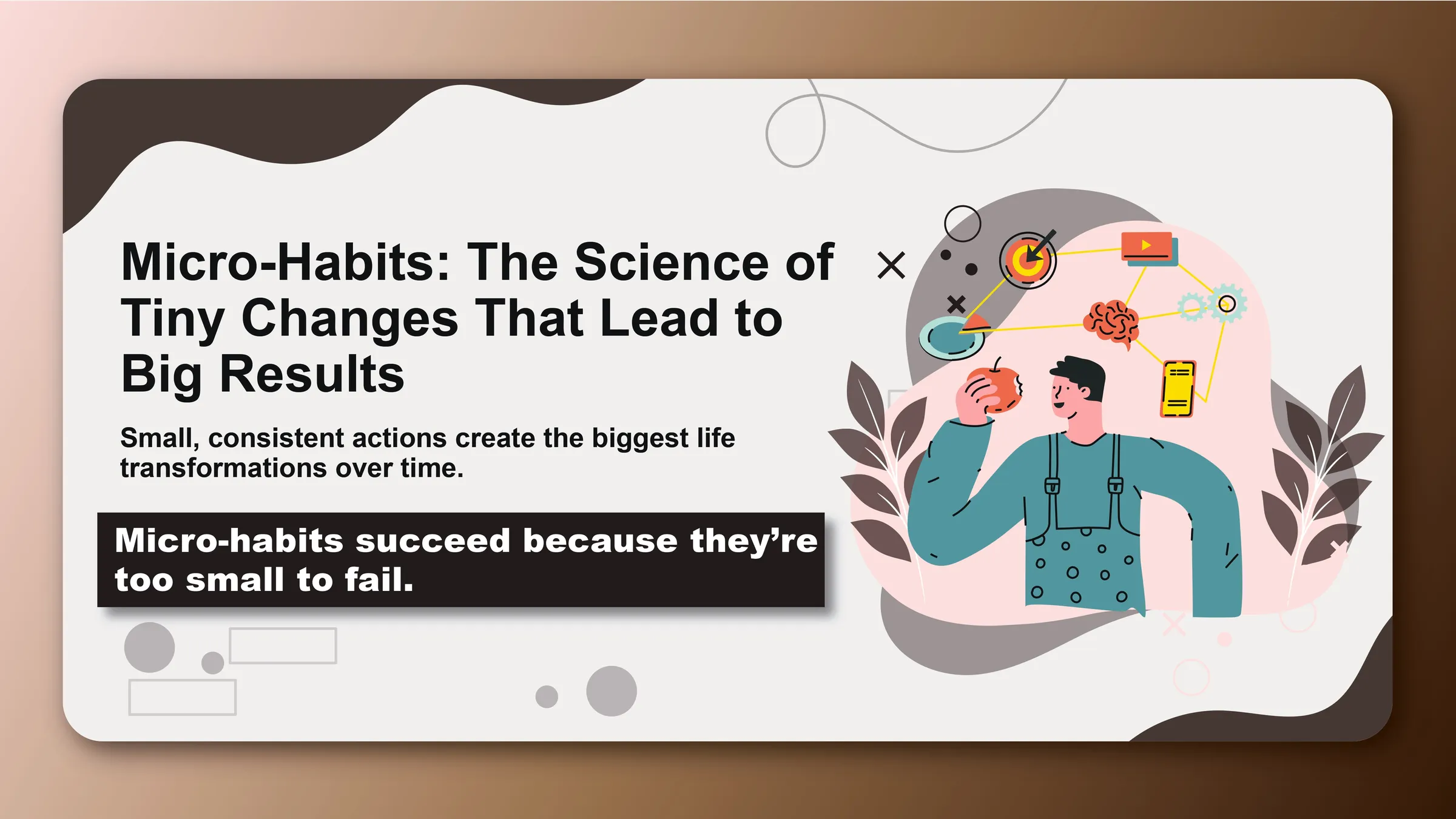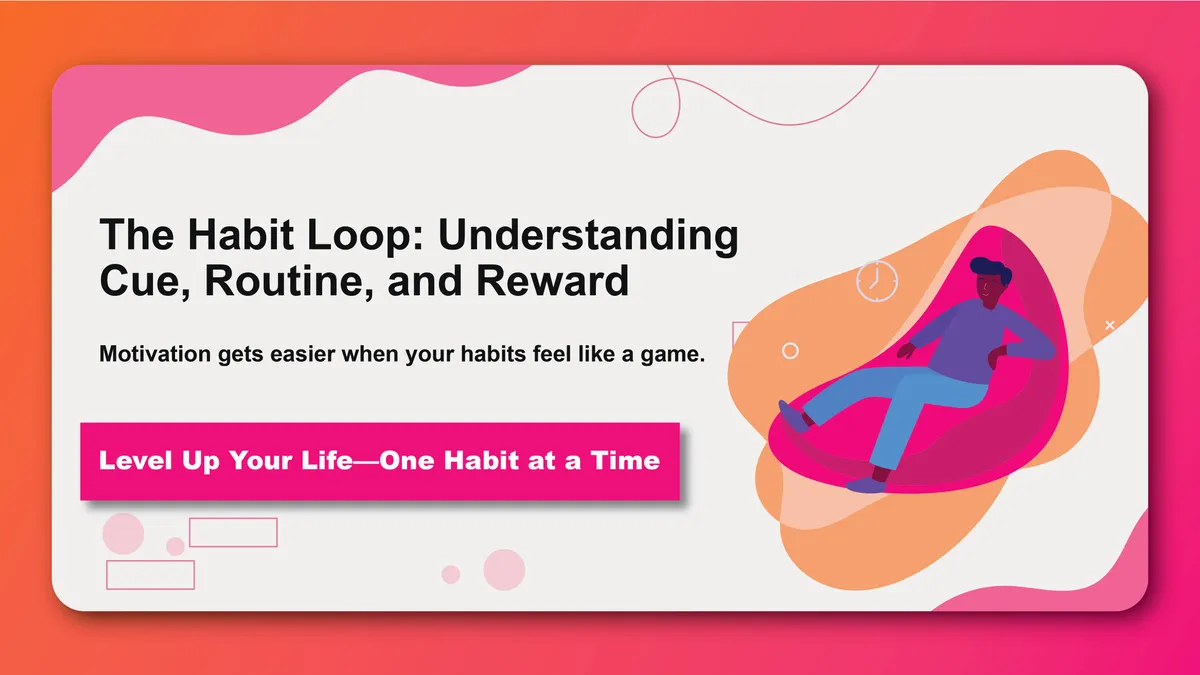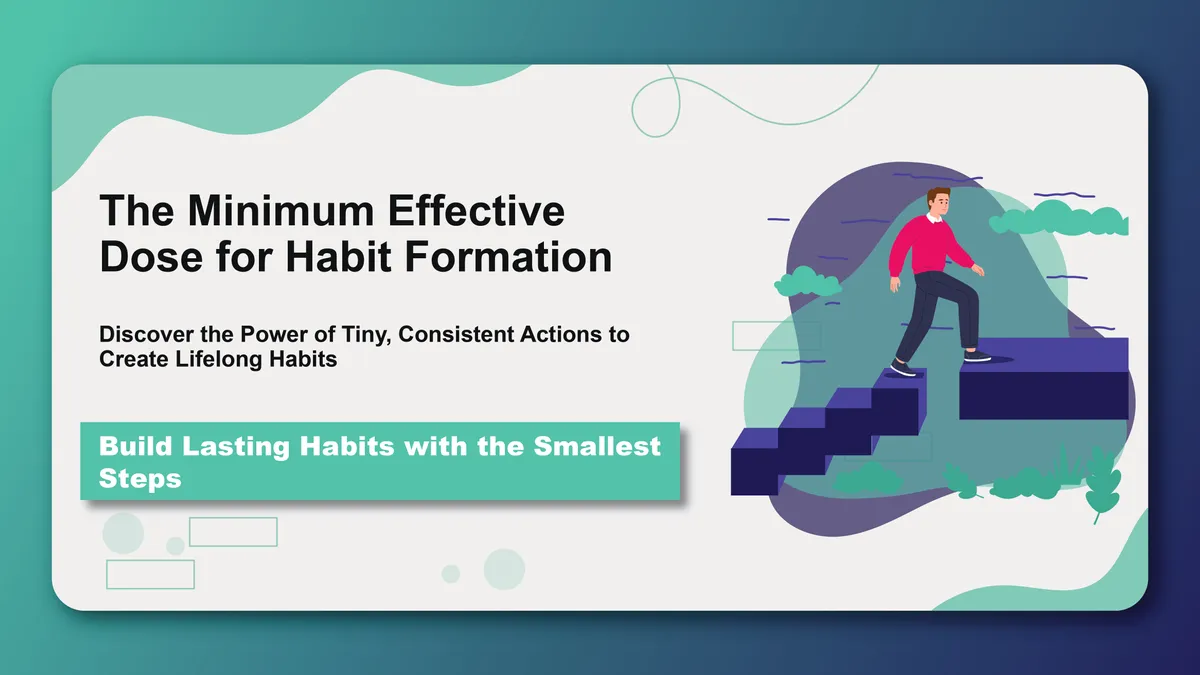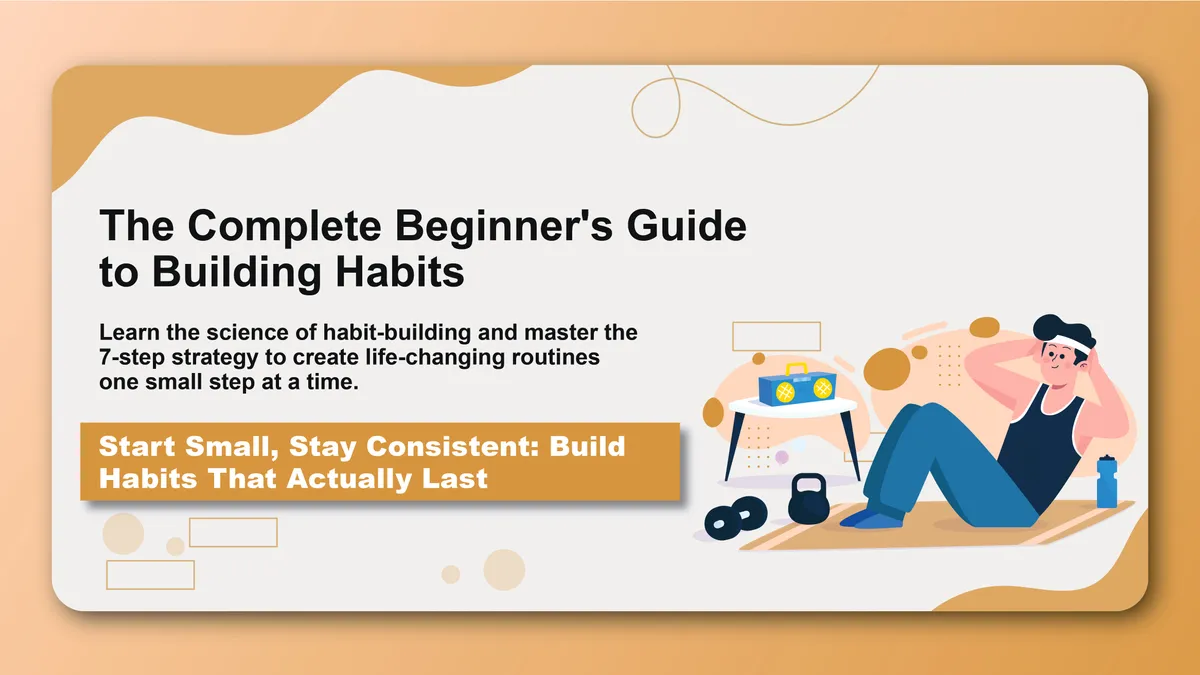What if the secret to transforming your life wasn't found in dramatic overhauls or massive lifestyle changes, but in actions so small they seem almost insignificant? Welcome to the world of micro-habits—tiny, consistent behaviors that compound over time to create extraordinary results.
Understanding Micro-Habits
A micro-habit is a small action that takes less than two minutes to complete and requires minimal willpower or motivation. These aren't simplified versions of larger habits; they're intentionally designed to be so small that they're virtually impossible to fail at, while still moving you toward your larger goals.
Key Characteristics of Micro-Habits:
- Duration: 30 seconds to 2 minutes maximum
- Minimal Effort: Requires little physical or mental energy
- Easy Success: Designed to be almost impossible to fail
- Daily Frequency: Performed consistently every day
- Gateway Effect: Naturally leads to larger behaviors
The Science Behind Micro-Habits
Neuroplasticity and Habit Formation
Research by Dr. Ann Graybiel at MIT shows that habits are stored in the basal ganglia, a region of the brain that can form neural pathways through repetition. Micro-habits leverage this neuroplasticity by creating new neural pathways with minimal resistance, allowing the brain to build strong habit circuits without triggering psychological reactance.
The Minimum Effective Dose
The concept of minimum effective dose, borrowed from medicine and exercise science, applies perfectly to habit formation. Micro-habits represent the smallest amount of behavior needed to create meaningful neural change and psychological momentum.
Cognitive Load Theory
Our brains have limited cognitive resources for making decisions and exerting willpower. Micro-habits require so little cognitive load that they bypass our brain's resistance mechanisms, making them sustainable even during stressful periods or when motivation is low.
Dopamine and Reward Systems
Each successful completion of a micro-habit triggers a small dopamine release, creating positive reinforcement that strengthens the habit loop. Because micro-habits are easy to complete, they provide frequent success experiences that maintain motivation for continued practice.
The Psychology of Small Wins
Success Momentum
Psychologist Karl Weick's research on "small wins" demonstrates that completing small, manageable tasks creates psychological momentum that makes larger challenges feel more achievable. Micro-habits capitalize on this principle by ensuring daily success experiences.
Self-Efficacy Building
Psychologist Albert Bandura's self-efficacy theory suggests that our belief in our ability to succeed is built through mastery experiences. Micro-habits provide frequent mastery experiences, building confidence in our ability to create change.
Identity Formation
Each time you complete a micro-habit, you reinforce your identity as someone who takes action toward your goals. These small identity shifts accumulate over time, creating profound changes in how you see yourself and what you believe is possible.
Types of Micro-Habits
Health and Fitness Micro-Habits
Physical Activity:
- Do one push-up immediately after getting out of bed
- Take the stairs instead of the elevator for one floor
- Park in the farthest spot from store entrances
- Stand and stretch once every hour while working
Nutrition:
- Drink one glass of water upon waking
- Eat one piece of fruit with breakfast
- Take one multivitamin after brushing teeth
- Chew food 20 times before swallowing at one meal
Sleep Hygiene:
- Put your phone in another room 30 minutes before bed
- Write down three things you're grateful for before sleep
- Set out tomorrow's clothes before getting into bed
- Turn off one electronic device 15 minutes earlier each week
Mental and Emotional Micro-Habits
Mindfulness and Meditation:
- Take three deep breaths before checking your phone
- Notice five things you can see during your morning commute
- Spend 30 seconds focusing on your breath at lunch
- Practice one minute of loving-kindness meditation before meals
Emotional Regulation:
- Name one emotion you're feeling when you wake up
- Write down one thing that frustrated you each evening
- Take a 10-second pause before responding to difficult emails
- Smile at yourself in the mirror every morning
Learning and Growth:
- Read one paragraph of a non-fiction book daily
- Learn one new vocabulary word during breakfast
- Listen to one song in a foreign language while commuting
- Write one sentence in a journal before bed
Productivity and Professional Micro-Habits
Organization:
- Clear your desk of one item before starting work
- File one document immediately after reading it
- Delete five unnecessary emails first thing each morning
- Put away one item that's out of place when entering a room
Communication:
- Send one appreciation message to a colleague weekly
- Practice one minute of small talk with a different person daily
- Ask one clarifying question in every meeting
- End every email with a clear next step
Skill Development:
- Practice one coding problem during lunch break
- Review one industry article while drinking morning coffee
- Spend five minutes researching one new tool or technique daily
- Shadow one colleague for 10 minutes weekly
Social and Relationship Micro-Habits
Connection:
- Text one friend "thinking of you" each week
- Compliment one person genuinely every day
- Ask one personal question in conversations
- Remember and use one new person's name daily
Family:
- Hug your partner for 10 seconds when you get home
- Ask your child one specific question about their day
- Express gratitude to one family member before dinner
- Put away one item that belongs to a family member
Implementing Micro-Habits: The TINY Method
T - Trigger
Attach your micro-habit to an existing routine or environmental cue.
Examples of Effective Triggers:
- After I pour my morning coffee...
- When I sit down at my desk...
- Before I check my phone...
- After I brush my teeth...
Trigger Selection Criteria:
- Already happens consistently every day
- Occurs at an appropriate time for your micro-habit
- Creates a logical sequence of actions
- Matches the energy level required for the habit
I - Identity
Connect the micro-habit to the identity you want to develop.
Identity Connection Examples:
- "I am someone who moves my body daily" (one push-up)
- "I am someone who learns continuously" (one paragraph reading)
- "I am someone who appreciates others" (one compliment daily)
- "I am someone who takes care of my health" (one glass of water)
N - Natural
Make the micro-habit feel natural and easy within your existing life.
Naturalness Factors:
- Fits seamlessly into current routines
- Doesn't require special equipment or preparation
- Can be done in your normal environment
- Aligns with your natural preferences and rhythms
Y - Yes-Able
Design the habit to be so small that you can't say no to it.
Yes-Able Criteria:
- Takes less than 2 minutes to complete
- Requires minimal physical or mental effort
- Can be done even on your worst days
- Success is virtually guaranteed
Advanced Micro-Habit Strategies
Habit Stacking with Micro-Habits
Link multiple micro-habits together to create powerful sequences.
Example Stacking Sequences:
- After I wake up → I drink one glass of water → I do one push-up → I write one grateful thought
- Before I start work → I clear one item from my desk → I take three deep breaths → I review my priorities
- After dinner → I wash one dish → I spend one minute tidying → I choose tomorrow's outfit
Progressive Micro-Habit Expansion
Start with a micro-habit and gradually expand it as it becomes automatic.
Expansion Timeline Example:
- Week 1-4: Read one paragraph daily
- Week 5-8: Read for 2-3 minutes daily
- Week 9-12: Read for 5 minutes daily
- Week 13+: Read for 10-15 minutes daily
Environmental Design for Micro-Habits
Modify your environment to make micro-habits easier to perform.
Environmental Modifications:
- Place a glass of water by your bed for morning hydration
- Keep push-up handles visible as a movement reminder
- Put a book on your pillow for bedtime reading
- Set out workout clothes for morning exercise
Seasonal Micro-Habit Cycles
Adapt your micro-habits to different seasons or life phases.
Seasonal Adaptations:
- Winter: Focus on indoor micro-habits like stretching and reading
- Spring: Incorporate outdoor micro-habits like brief walks
- Summer: Emphasize hydration and sun protection micro-habits
- Fall: Develop reflection and planning micro-habits
Common Micro-Habit Mistakes
Making Them Too Big
The Problem: Starting with habits that seem small but still require significant willpower.
The Solution:
- Reduce the habit to its absolute minimum viable version
- Test whether you can do it on your worst day
- Focus on consistency over intensity
- Remember that the goal is neural pathway creation, not immediate results
Inconsistent Triggers
The Problem: Choosing triggers that don't happen reliably every day.
The Solution:
- Select triggers from your most consistent daily routines
- Avoid triggers tied to other people or external circumstances
- Choose physical actions rather than mental states as triggers
- Test your trigger for a week before committing to the habit
Lack of Clear Identity Connection
The Problem: Performing micro-habits without connecting them to larger identity goals.
The Solution:
- Define the identity you want to develop
- Explicitly connect each micro-habit to this identity
- Celebrate completions as evidence of your identity development
- Regularly remind yourself why the micro-habit matters
Impatience with Results
The Problem: Expecting dramatic changes from small actions in short timeframes.
The Solution:
- Focus on the process rather than immediate outcomes
- Track consistency rather than results
- Trust in the compound effect of small actions
- Celebrate the habit formation itself as a significant achievement
Measuring Micro-Habit Success
Consistency Metrics
Daily Completion Rate:
- Track the percentage of days you complete each micro-habit
- Aim for 90%+ consistency over 30-day periods
- Use visual tracking methods like calendars or apps
- Celebrate streaks while not being derailed by breaks
Habit Strength Indicators:
- The habit feels automatic and requires no conscious decision
- You perform it even when tired, stressed, or rushed
- Missing it feels uncomfortable or "off"
- You can complete it without thinking about the steps
Gateway Effect Measurements
Natural Expansion:
- Document when micro-habits naturally lead to larger behaviors
- Track how often one push-up becomes a full workout
- Notice when one paragraph reading becomes extended reading
- Measure spontaneous related behaviors that emerge
Identity Development:
- Regular self-assessment of identity alignment
- Recognition from others about your changed behaviors
- Increased confidence in your ability to create change
- Natural adoption of related positive behaviors
Troubleshooting Micro-Habit Challenges
Motivation Fluctuations
Challenge: Some days you don't feel like doing even the smallest habit.
Solutions:
- Remind yourself it takes less than 2 minutes
- Focus on maintaining your identity rather than the behavior itself
- Use the "just this once" mindset to prevent complete stopping
- Remember that motivation follows action, not the reverse
Perfectionism
Challenge: Feeling like micro-habits aren't enough or meaningful.
Solutions:
- Understand that micro-habits are foundation-building, not the end goal
- Track the compound effects over months, not days
- Celebrate the development of discipline and consistency
- Trust in the process of gradual expansion
Social Skepticism
Challenge: Others questioning why you're focusing on such small actions.
Solutions:
- Share the science behind micro-habits and compound effects
- Focus on your personal journey rather than external validation
- Let your results speak for themselves over time
- Connect with communities that understand micro-habit principles
Long-Term Micro-Habit Success
The Compound Effect
Micro-habits create compound results through:
- Neural Pathway Strengthening: Each repetition makes the habit more automatic
- Identity Reinforcement: Small actions create lasting identity changes
- Confidence Building: Success in small areas builds capability beliefs
- Gateway Opening: Micro-habits naturally expand into larger behaviors
Building a Micro-Habit System
Create a comprehensive approach by:
- Developing micro-habits in different life areas simultaneously
- Connecting habits through stacking and environmental design
- Regularly evaluating and adjusting your micro-habit collection
- Expanding successful micro-habits while maintaining their core simplicity
Legacy of Small Actions
The true power of micro-habits lies not in the individual actions themselves, but in what they represent: your commitment to growth, your belief in the possibility of change, and your understanding that transformation happens one small step at a time.
Remember, every expert was once a beginner, every master was once a disaster, and every success story started with a single, small action. Your micro-habits are not just tiny behaviors—they're the building blocks of the person you're becoming.
Ready to harness the power of small changes? Start tracking your micro-habits with Habityzer and discover how tiny actions can create extraordinary transformations in your life.



